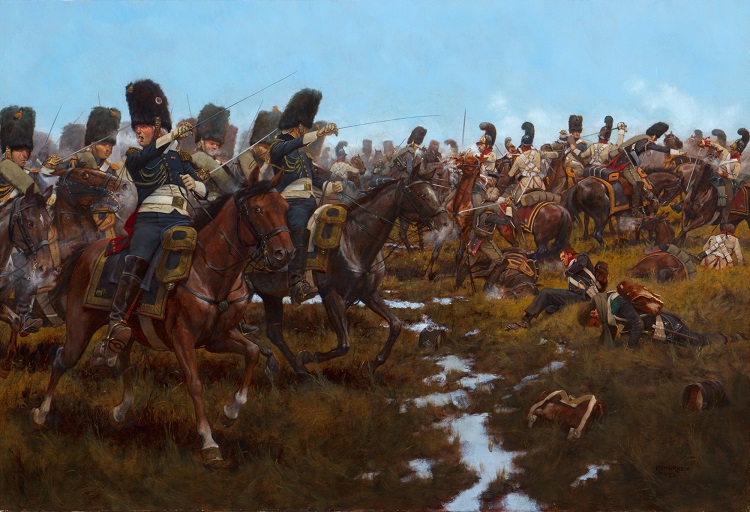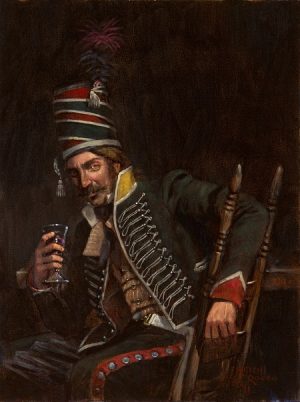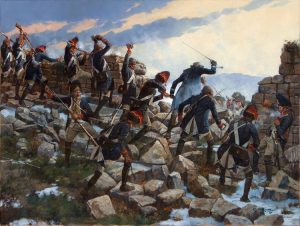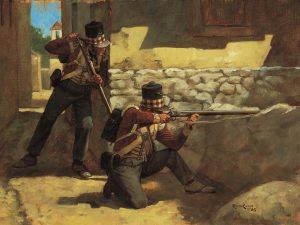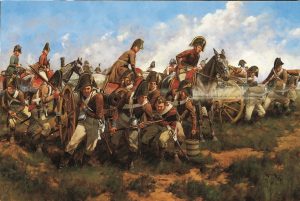The Gods of Austerlitz
Description
50 signed and numbered prints
Austerlitz- the name of the battle that is synonymous with the glory of Napoleon’s First Empire, was fought in 1805 on a cold December 2nd in the modern-day Czech Republic.
Although there were many epic occurrences during the battle that involved armies totaling 160,000 combatants, few approach the mystique of the French attacks by the cavalry regiments of the Guard.
For the first time of the day, the French battleline was in danger when two infantry regiments, the 4th Lina and the 24th Light, were put to flight by the Russian cavalry of the Guard. Russian infantry was poised to fill and exploit this breach in the French line. Napoleon himself and some of his Imperial staff tried in vain to stem this break in the dike but after suffering staggering losses from the blades of the Russian Gardes du Corps cavalry, the 4th and 24th melted away. Napoleon smiled pitifully then said, “let them go”. Now, seeing first-hand this impending disaster unfold, Napoleon turned to Marshal Bessieres, commanding the French Imperial Guard, and ordered a counter-attack.
“The Emperor gave me the order to go forward with the cavalry to support the 4th regiment of the line and the 24th regiment of light infantry, strongly engaged with the enemy. I immediately had Colonel Morland advance on the left with two squadrons of the Chasseurs a Cheval de la Garde, with the order of falling on the enemy infantry in order to break them. I perceived that the enemy wanted to outflank our right; I immediately sent General Ordener with three squadrons of Grenadiers a Cheval de la Garde to contain them, and the Prince Borghese with his squadron in echelon on the right of General Ordener…”
From Marshall Bessiere’s after action report.
To Colonel Morland of the Chasseurs a Cheval de la Garde, known as “The Favored Children” and General Ordener commanding the Grenadiers a Cheval de la Garde, whose sobriquet was, “The Gods”, fell the order to attack. Morland’s two squadrons and Ordener’s three squadrons descended onto the flank of the Russian cavalry squadrons, shattering them and, in the case of the Grenadiers, capturing a standard. The impetuous attack carried on into the supporting Russian infantry who, though assaulted by saber, pistol and even French horse artillery would not break and were able to hang on until Guard Cossacks and the Chevalier Garde came to their succor.
It was now for the French to stand against superior odds. A huge melee swirled between French and Russian Guard cavalry, the finest cavalrymen of opposing armies testing their mettle and talents of swordsmanship against each other. Napoleon, seeing the uneven numbers ordered General Jean Rapp, an Imperial aide-de camp, into the fray saying, “General, there is a mess there; go and put it right.” Leading the last squadrons of Guard cavalry, Rapp’s Chassuers and Mameluks fell upon the Chevalier Garde which broke and fled in disorder.
Now occurred a massive combat of cavalry with infantry on the fringes of the struggling horsemen. As squadrons became winded, they would disengage, rest behind and under the protection of the infantry blocks, then charge once again into the swirl. Minute by minute superior French training began to tell and though, still outnumbered, the Chasseurs, Grenadiers and Mameluks pushed back the Russians until finally the latter collapsed, staggering from the field.
The French guardsmen, free of the Russian Guard cavalry, turned their vengeance against the Russian infantry who, having lost their supporting mounted comrades were hacked into routing from the field. In the end, the result of a combat that lasted 30 minutes was decidedly in favor of Napoleon’s Guard cavalrymen. (Sometime during the attack on the Russian infantry, Colonel Morland was shot from his horse by a Russian bullet. See Keith Rocco’s, “A Chasseurs Fate” for a depiction of this action.) Philippe de Segur, aide to Napoleon, went forward with the Emperor and his staff to survey the recent sanguinary scene. He remembered, “A whole row of (Czar) Alexander’s unfortunate Garde du Corps lying on the ground with their death wounds in front, encumbered the spot where this terrible encounter had taken place. Other lines of dead and wounded, with the knapsacks of the infantry, (which it is the Russian custom to deposit on the ground at their feet before entering combat) indicates the other positions where the infantry of the enemy’s Guard succumbed…”
Where the Grenadiers a Cheval had worked their butchery, another witness wrote, “whole companies were heaped in bloody piles along their original alignments.”
ABOUT THE PAINTING
Following Morland’s initial charge, a succession of charges and countercharges ensued between the two Horse Guards. After initially positioned to contain them, General de Brigade Michel Ordener is depicted here at the head of at least two squadrons of Grenadiers finding the opportune time to charge the Chevaliers-Gardes. To his left is his son also named Michel and a future general, who at 19 years old was his ADC. He would later fight in many campaigns including at Waterloo, and was fond of recollecting how at Austerlitz, his father scolded him for leaning in his saddle to avoid cannon balls during the charge. The Grenadiers ultimately captured Prince Repnine, his officers, and 27 guns. Ordener’s action was rewarded a few weeks later with a promotion to General de Division.
Additional information
| Medium | |
|---|---|
| Size | 19" x 28" |
| Type |

